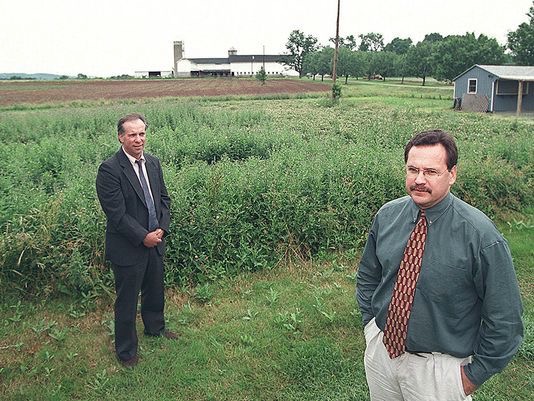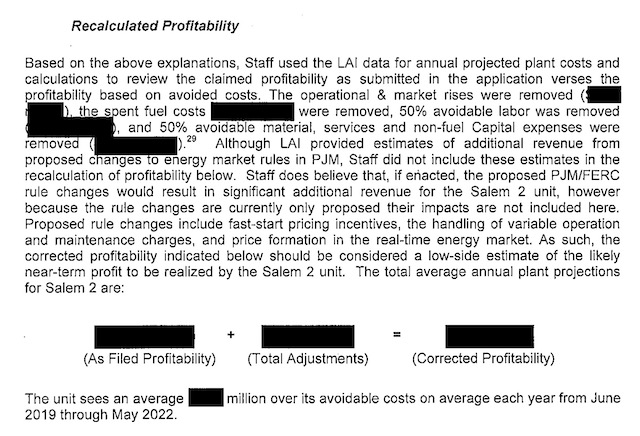Private Corporate Planning Portrayed As Public Interest Advocacy
Citizen Land Use Victories Ignored, While Ineffective Solutions Divert From What Works
Assuming Defeat Before The Battle Is Engaged
I’ve often criticized private – often elite Foundation and corporate funded – groups like NJ Future for falsely framing issues, trying to control the narrative, and to define the range of “feasible” public policy solutions to those issues. They offer up incremental and ineffective “solutions” that benefit their corporate donors while diverting attention from real solutions, manipulating and disempowering the public, and thereby undermining democracy. They disguise their corporate agendas behind a veneer of public interest slogans: sustainable development, regional planning, environment, infrastructure, jobs, brownfields redevelopment, urban redevelopment, and most recently, “equity”.
The warehouse sprawl issue is a classic example of all that.
Today, NJ Spotlight ran another important story about warehouse development and land use issues, see:
Today’s revised focus towards the need for state and regional planning appears to respond to a strong criticism I made of their prior coverage back in November, see:
I say appears to respond for a reason – because it doesn’t. In fact, it does just the opposite. It doubles down on diversion.
Here’s the thrust of my prior criticism of NJ Spotlight’s failures that today’s story appears to respond to. Back in November, I wrote:
The solutions are regional planning and regulatory powers enforced by State and regional institutions (not county and local governments).
NJ has a well developed, time tested, and legally valid effective suite of State and regional planning and regulatory laws and institutions, i.e. 1) the NJ State Development and Redevelopment Plan and The State Planning Commission; 2) The Highlands Act, Regional Master Plan, and Highlands Council; and 3) the Department of Environmental Protection land use and water resource planning and permitting programs (as well as the State Department of Transportation).
While NJ Spotlight’s new emphasis shifted from local land use powers to the need for State and regional planning, it did so in a way that actually undermines and basically dismisses those approaches. Let me explain.
The story is based on a paper by Tim Evans of NJ Future. That paper is written from an economic development perspective.
Confirming my critique of NJ Future as a corporate planning group that masks corporate economic interests behind the mantle of faux public interest platitudes, it celebrates the growth of global trade, expansion of NJ ports and warehouses, and economic growth. Mr. Evans opens his paper with this revealing statement (emphasis mine):
Thanks to growth in both e-commerce and the volume of trade at the Port of New York and New Jersey, the amount of land needed for warehousing has been growing.
Thanks for nothing. This is neoliberal corporate shilling, not public policy or land use planning.
Mr. Evans further reveals his economic development and corporate objectives with this quote:
“Leaving the fate of one of New Jersey’s most important industries, and the decisions about where its need for land is accommodated, solely in the hands of our myriad local governments and their fiscal self-interest is no guarantee of a regionally-optimal solution,” wrote Tim Evans, director of research for the nonprofit New Jersey Future
Note that Mr. Evans does not disclose what he is seeking to “optimize” and NJ Spotlight didn’t even ask this fundamental question. If asked, he likely would say “efficiency” or “sustainability”, but those are just slogans and another technocratic smokescreen for corporate profits, rape of the landscape, and even more pollution and greenhouse gas emissions.
But instead of exposing the NJ Future charade, Jon Hurdle of NJ Spotlight perpetuates and strengthens it. This is really unforgivable, because I reached out to Hurdle to warn him, most recently back in November:
3) NJ Future – and groups like “Sustainable NJ” – have foolishly relied primarily on local governments, the NJ Municipal land Use Law, and voluntary private sector actions, while neglecting or even criticizing State, regional, and regulatory powers.
Just like the political actors, they too now are covering their asses for major strategic mistakes.
Why do you so consistently rely on sources that provide a false framing?
But that’s not close to several other highly misleading and distorted perspectives expressed in that one story.
How could a land use and regional planning focused story ignore – completely – NJ’s existing regional planning institutions, laws and regulations? The only “regional planning” authority Hurdle mentions is the North Jersey Transportation Planning Authority.
Again, I advised Jon Hurdle about that back in November:
John – there are 3 major omissions from your story that cry out for a followup:
1) Conservative anti-government and anti-regulatory officials and citizens in Warren and Sussex County have long strongly opposed the State Development and Redevelopment Plan, the Highlands Council, The RMP, and the DEP’s various regional planning and regulatory programs. (“Home rule”, “takings”, “State mandates” “red tape” etcetera)
How could a land use and transportation story ignore the climate emergency?
How could the need for Farmland Preservation, the effective power of State regulation, and the need for new law that preserves farmland be ignored? Why does NJ Spotlight ignore that possibility?
How could NJ’s regional planning and regulatory history be ignored? Again, we noted this context back in November:
So, why does the Spotlight story not only omit all that and focus exclusively on local and county voluntary coordination and demonstrably weak and ineffective tools under the “home rule” oriented NJ Municipal Land Use Law?
That failure is the result of reliance on sources that are right wing political ideologues. These folks serve in places of government power and are supported by residents in places like Warren and Sussex County who have long opposed the any role for State government (or the Highlands Council).
They opposed the State Plan, The Highlands Act, and the DEP.
Because groups like NJ Future and Sustainable NJ have duped and diverted well meaning residents and activists.
Of course, none of that history, context, law and institutions was mention in NJ Spotlight’s story.
Instead, NJ Spotlight again was duped by those who now need to cover their asses for huge strategic and political mistakes.
Yes, Mr. Hurdle did reframe the story and solicit the input of other perspectives and sources.
But his reframing again relies primarily on NJ Future’s economic development narrative (without disclosing that fact) and the other perspectives and sources are used as straw men, to be knocked down.
1. The myth of “Home rule” is strengthened, not exposed:
Municipalities, which have authority over land use, are attracted to the local taxes and jobs that come with new warehouses and many approve the plans over the objections of local critics.
This is legally a false statement. Municipalities are delegated limited land use power by the State legislature, under the State’s constitutional police power.
2. The powers of State government and the politics of land use are distorted:
“It’s a home-rule state, and local governments have the final say,” he said. “It’s hard to reel that power back once you’ve handed it to the local governments; you are going to meet a lot of political resistance if you say you need to take some of it back.”
Again, these statements are factually false. Local governments do not have “the final say”. Under NJ law, regional entities like the Highlands Council and the Pinelands Commission have final say within their regions. Under NJ law, State regulatory agencies like the DEP have final say on infrastructure, water resources, and many environmental issues. Under NJ law, the Legislature has “taken back” local land use powers many times (from the Freshwater Wetlands Protection Act, to the Flood Hazard Control Act, to coastal land use under CAFRA.)
The politics of those issues was controversial, but they were strongly supported by public opinion (aka “democracy”), which is something pro-corporate Mr. Evans doesn’t want to talk about.
But it is unforgivable for NJ Spotlight to frame the issues this way and by ignoring prior citizen driven victories and assuming defeat before the battle is even engaged.
But that is exactly what NJ Future is designed and funded to do and why they are involved in the issue.
3. The debate over putting teeth in the State Plan is ignored:
Mike Cerra, executive director of the New Jersey League of Municipalities, argued that land-use decisions are best left in local hands, and that the official State Plan — a document that recommends where and how the state should grow — has not been widely accepted since it was last issued in 2001.
Beginning with Gov. Florio’s Executive Order #114, NJ Governor’s have used their powers to control land use and integrate the “voluntary” State Plan in DEP regulatory programs.
Instead of reporting this fact, NJ Spotlight prints lies from Mr. Cerra of the NJ League of Municipalities:
“The State Plan has never been bought into by the respective state agencies, and has led to disjointed outcomes.”
“Open For Business” Gov. Whitman’s first Executive Order #1 undermined the land use focus of the State Plan and power of the State Planning Commission by forming an Economic Master Plan Commission.
Gov. Corzine issued Executive Order #114 directing “stronger implementation of the Highlands Master Plan”.
Gov. McGreevey’s DEP Commissioner Brad Campbell foolishly tried – and failed – to usurp the State Plan via his “Big Map” initiative in 2002, see:
But McGreevey over-rode Campbell’s strategic errors by successfully enacting the Highlands Act which protected almost 1 million acres and the DEP “Category One” streams buffer protection program, which prohibited development of over 150,000 acres of NJ’s most environmentally sensitive lands. Of course NJ Future doesn’t want to talk about this, but it is incredible that Mr. Hurdle ignored this.
But it was Gov. Christie’s Executive Order #78 that went even further than Whitman and dismantled the State Plan by replacing it with a Strategic Economic Development Plan. In light of this fact, it was journalistic malpractice for Mr. Hurdle to allow the NJ League Of Municipalities to lie about this, i.e. that the state Plan “has not been widely accepted since it was last issued in 2001.”
NJ Spotlight and their State Plan sources completely ignore this history.
4. It gets so absurd that State planning powers are downplayed by State officials who should be advocating them:
Municipalities are not required to conform to the State Plan, which is a guidance document, said Donna Rendeiro, executive director of the state’s Office of Planning Advocacy. She said final land-use decisions are made locally but state or regional authorities can help towns with information or technical assistance, in cases that have a wider impact.
5. Academic experts are curiously completely baffled about planning and regulatory tools:
Regional coordination of warehouse development “would make a lot of sense,” said John Hasse, a Rowan University professor who monitors land-use patterns. It’s unclear what policy tools might enable that to happen, but regional management of impervious surface expansion might allow coordination while retaining local authority over the issue, he said.
6. Even former State Planning Commission members simply can’t communicate an effective and enforceable response and tell the truth:
Jim Gilbert, a former chairman of the New Jersey State Planning Commission, urged Gov. Phil Murphy, who appoints the panel’s chairman and executive director, to empower the commission to require counties to coordinate planning.
He acknowledged that such a change would reduce municipalities’ power over land-use decisions, but argued that it would reduce the threat of warehouse development on greenfield sites, as proposed in White Township, Warren County, where a developer wants to build 2.8 million square feet of warehouse space on farmland, a project that Gilbert said would “destroy” the county.
“There are responsible developers who redevelop existing industrial sites, and others who want to build in the middle of a cornfield,” he said.
7. At the very end of a long story, the only knowledgeable voice with integrity – Jeff Tittel of Sierra Club, who has been in the trenches on these battles for decades and is fully aware of all of the above – was marginalized and limited to a single project in Ocean County.
Worse, he was then undermined and contradicted by Mr. Evans of NJ Future.
That is disgusting and unforgivable bullshit. So, I fired off this brief email note to Mr. Hurdle:
Jon – I just read NJ Future’s Tim Evans paper you sourced.
It could have been written by the Chamber of Commerce or NJBIA.
Don’t you owe your readers that knowledge?
Instead, you cherry picked 2 sentences from the paper to reinforce the false impression of NJ Future and it’s agenda..
I’ve told you several times (backed up by links to their Board and examples) that NJ Future is a corporate dominated organization that uses “planning” to promote corporate economic objectives.
To add insult to injury, you ignored NJ’s rich regional planning history, existing regional planning institutions (Highlands, Pinelands, HMC, DEP) and the efforts to put teeth in the NJ State Plan via DEP regulations and regional planning water and infrastructure powers.
BTW, Gov. Christie abandoned the State Plan’s land use planning orientation and changed it to a strategic business/economic development plan, another highly significant fact that you obscure with a backhanded reference.
You must do better.
Wolfe
(Cornell Graduate School, City and Regional Planning, 1983-1985, plus 35 years of NJ planning and regulatory experience).
[End Note: I’ve warned Mr. Hurdle about NJ Future multiple times, so today’s story is no mere oversight or lazy reporting. It’s intentionally misleading. We told you so, when I wrote the following:
[…]
And just as we predicted, NJ Future supported private corporate interests and the allocation of a larger burden of costs to ratepayers.
But NJ Future – echoing the greed of private water companies – went even further to argue that people should pay 100% of the infrastructure upgrade costs, with private companies paying ZERO!
The utilities, for example, want ratepayers to pay the whole cost of infrastructure upgrades — but that, he said, would be “unfair.”
New Jersey Future, too, wants ratepayers in all but the most impoverished areas to pay all the cost for lead service line replacement, [NJ Future’s] Sturm said. She argued that the costs would be modest when spread across most ratepayers.
We predicted exactly this would happen:
Today, privatization and Foundation abuses combine, in an effort to hijack the agenda for responding to the public health crisis of lead in drinking water, see: Jersey Water Works Forms Task Force Focused on Lead in State’s Drinking Water. […]
The work of the Task Force is under the control of NJ Future, a “planning” group with a corporate and development oriented Board and a very checkered political history, going back to “smart growth” collaboration with the Whitman administration and more recently including secret planning with the Christie administration to privatize and develop Liberty State Park, a failed scheme (as the Bergen Record reported:)
Of course, the Task Force includes several representatives of the water companies that seek to avoid high cost real solutions, like regulatory mandates and community involvement to solving the lead problems.
NJ Future is not a public health, environmental or public interest group. They are a private group who represent corporate and development interests. They have no membership other than the corporate interests on their Board and the private foundations who fund them.They are a classic example of what I’ve called Green Cannibals.
Why is NJ Future considered a legitimate public “Stakeholder” by Legislators and the media spokespersons on this critical public issue?
I fired off this email to NJ Spotlight reporter Jon Hurdle and his editor John Mooney:
Jon – your report today:
“New Jersey Future, too, wants ratepayers in all but the most impoverished areas to pay all the cost for lead service line replacement, Sturm said. She argued that the costs would be modest when spread across most ratepayers.”
You need to disclose to readers who NJ Future represents – look at their Board and look at who funds them. Look at the membership of the coalition they are involved in and who funds them. NJ Future is NOT a public interest, public health, or environmental advocacy group. Your readers deserved to know that. And why would such a private and biased group be the lead spokesperson on a public health issue?
We warned folks that exactly this would happen, see:
Foundation Elites and Private Water Companies Hijack Lead In Drinking Water Issue
http://www.wolfenotes.com/2019/01/foundation-elites-and-private-water-companies-hijack-lead-in-drinking-water-issue/
Wolfe







